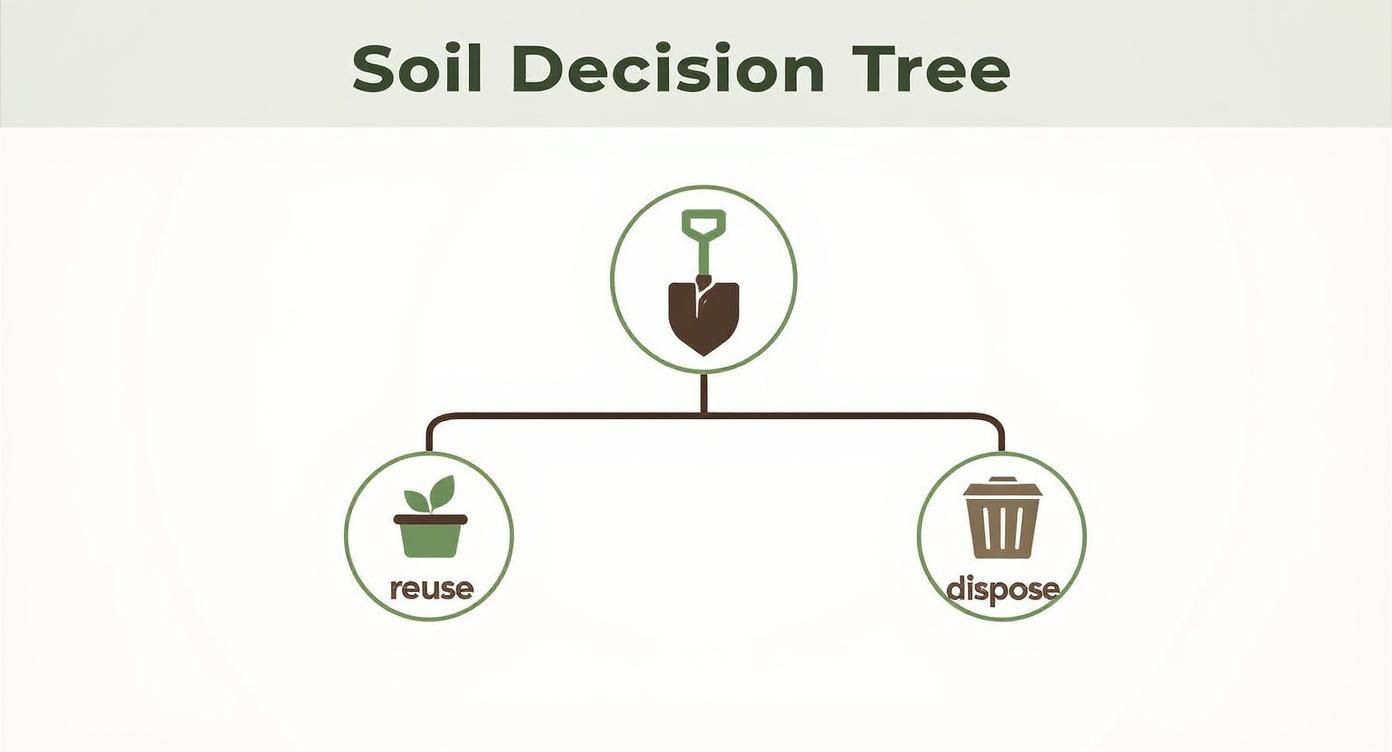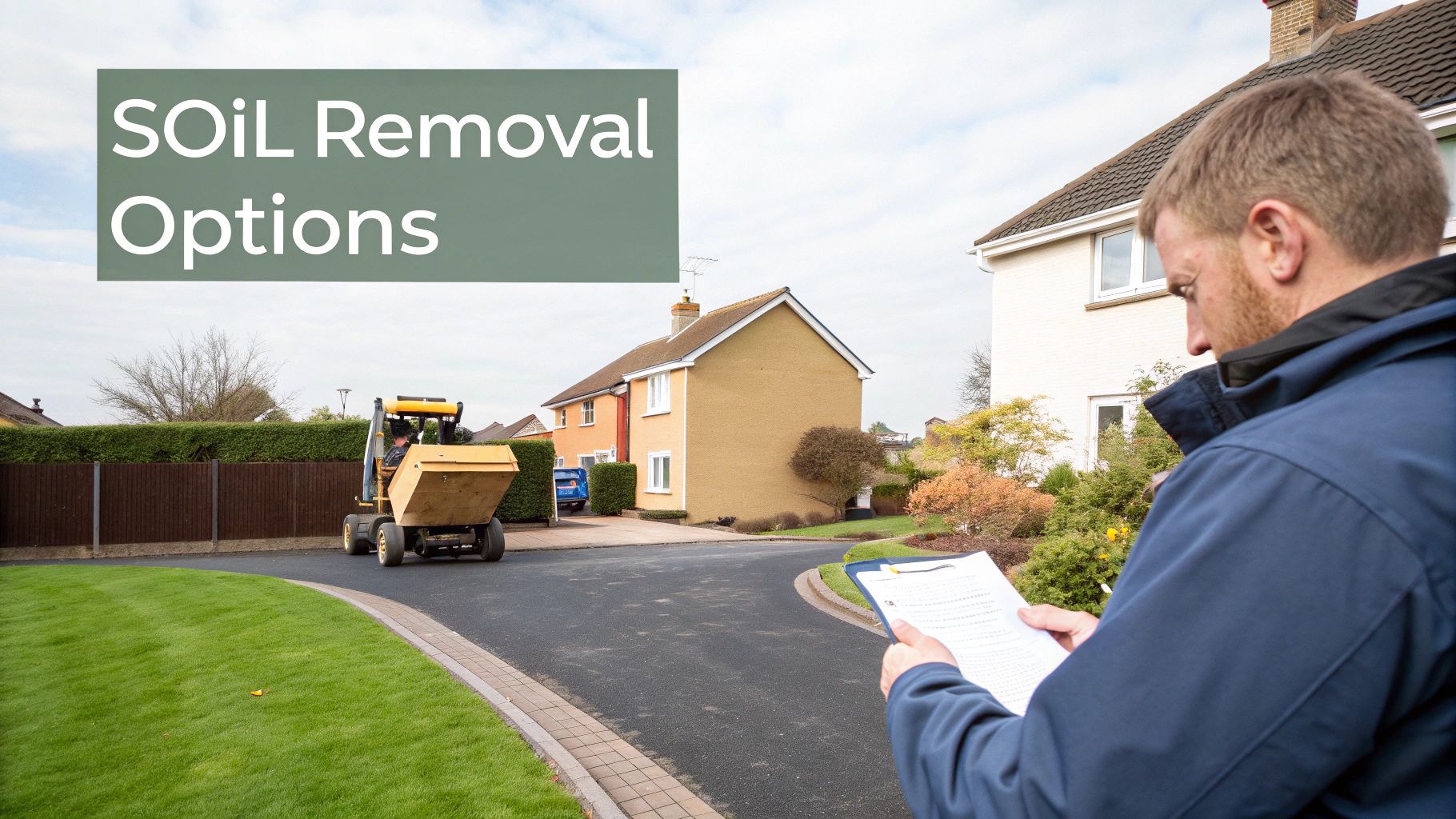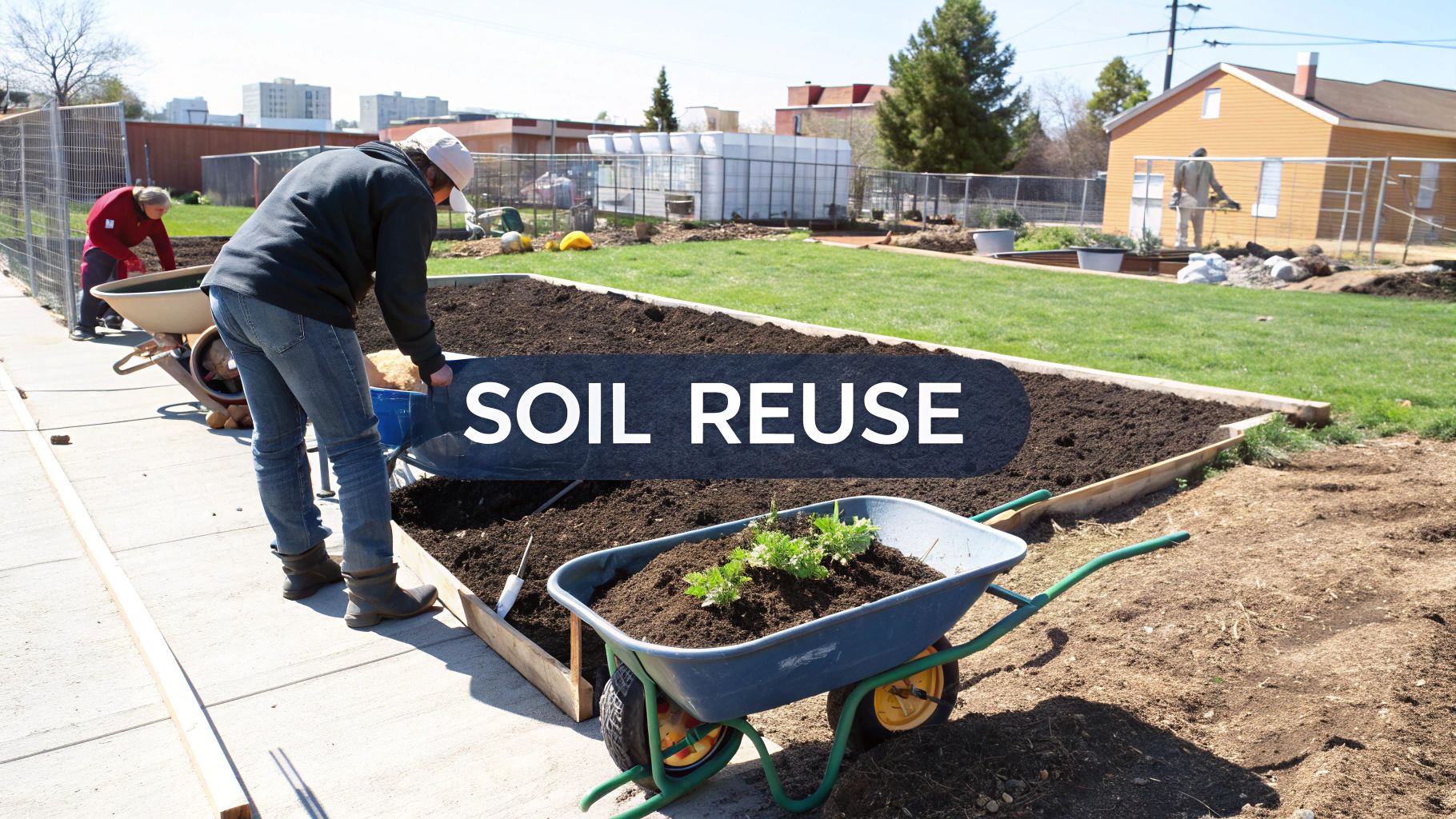A Homeowner’s Guide to Disposal of Soil in the UK
A Homeowner’s Guide to Disposal of Soil in the UK
Getting rid of soil isn't as straightforward as you might think. It’s not just about digging it up and finding a spot to dump it. In the UK, soil disposal is a tightly regulated process, and for good reason. Whether you're a homeowner tackling a garden project or a contractor clearing a major site, getting a handle on the rules from day one is non-negotiable.
Why Getting Soil Disposal Right is a Big Deal
The leftover soil from a project can often feel like an afterthought, but in reality, it's one of the UK's biggest environmental challenges. If you get it wrong, you could be looking at land contamination, damage to local ecosystems, and some pretty hefty fines. The whole point of the regulations is to make sure this waste is handled safely, protecting both people and the environment.
This means you can’t just chuck soil in with your general waste or tip it on any old bit of land. It needs to be properly identified, classified, and then taken to a licensed facility that can handle it. Sorting this out early on will save you a world of headaches, project delays, and surprise costs down the line.
Figuring Out What Kind of Soil You’ve Got
The first proper step in any soil disposal job is to work out exactly what you're dealing with. UK regulations generally split soil into three main categories, and each one has its own rulebook for handling and disposal.
- Inert Waste: This is the clean stuff. Think natural topsoil from a garden that hasn't seen any development. It’s soil that hasn’t been chemically or biologically altered and won't react with anything it touches.
- Non-hazardous Waste: This is soil that might have low levels of contaminants but isn't considered an immediate threat. It often comes from land that's been built on before but doesn't contain anything particularly nasty.
- Hazardous Waste: This is the serious stuff. Soil is classed as hazardous if it contains things that can harm people or the environment, like asbestos, heavy metals, oils, or industrial chemicals. This type of soil requires a specialist approach, and you can get the full picture on the strict hazardous waste disposal regulations in our detailed guide.
Getting the classification right is absolutely critical. Trying to pass off hazardous soil as inert to cut costs, for example, is a false economy that can land you in serious legal trouble and cause real environmental harm.
The Sheer Scale of the Soil Waste Problem
To put it into perspective, the amount of soil being dug up across the country is massive. It actually makes up a huge chunk of all the waste we send to landfill. Defra's 2022 statistics were a real eye-opener, revealing that soil makes up around 58% of the total tonnage dumped in UK landfills, mostly from construction and engineering works.
It’s a strange situation when you think about it—all this valuable, perfectly reusable topsoil is ending up buried and lost forever. Managing your soil disposal correctly isn't just about ticking boxes and following rules; it's about being part of a more sustainable solution.
How to Classify Your Soil for Removal
Before you even think about hiring a skip or arranging for soil removal, you need to know exactly what you’re dealing with. Getting your soil classified correctly isn't just a bit of admin; it's the most critical step. It dictates your disposal options, how much it will cost, and what your legal duties are.
Get this part wrong, and you could be looking at rejected loads at the tip, nasty fines, or even causing environmental damage. It pays to get it right from the start.
First things first, you need to figure out if you have naturally occurring topsoil or what's known as 'made-ground'. If your garden has always been a garden, the soil is likely natural and straightforward to deal with. But if your property has seen any kind of construction, demolition, or industrial activity in the past, you could well be digging into made-ground, which has a much higher chance of containing hidden contaminants.
Spotting Potential Contamination
You don't need a lab coat and a microscope to do an initial check. A simple visual and sensory inspection of the soil can often raise immediate red flags, telling you that a professional test is probably in order.
Keep your eyes (and nose) open for these tell-tale signs:
- Unusual Colours or Stains: See any patches of brightly coloured or unnaturally dark soil? This could point to chemical spills or buried waste.
- Strange Smells: Natural soil has a distinct earthy smell. If you get a whiff of anything chemical, oily, or like solvents, that's a major warning.
- Non-Soil Debris: Be on the lookout for bits of brick, concrete, plastic, glass, or anything that looks like it might be asbestos-containing materials (ACMs) mixed in.
- Sheen on Water: If you notice a rainbow-like film on puddles in the area you're excavating, it’s a classic sign of hydrocarbon contamination.
For smaller domestic jobs where you just want to be sure, testing your soil at home can help you classify it properly before deciding on the next steps.
If you spot anything that looks or smells like contamination, stop what you're doing right away. Disturbing potentially hazardous material without the proper precautions is both dangerous and illegal. The price of a professional test is nothing compared to the fines for improperly disposing of hazardous waste.
When a WAC Test is Necessary
When you’re dealing with a larger project, or if you have any reason to suspect contamination, a Waste Acceptance Criteria (WAC) test becomes crucial. It’s important to understand that a WAC test doesn't actually identify what the contaminants are; instead, it determines how the soil will behave once it’s in a landfill environment.
A WAC test is a legal requirement if you plan on sending any non-hazardous or hazardous soil to a landfill.
Clean, inert soil generally doesn't need a WAC test if it's going to an inert landfill or a recycling facility. However, the site receiving the soil will still want some proof that it is genuinely inert, which usually means providing a basic chemical analysis report.
This decision tree gives you a simple look at the choices you face when you've got a pile of soil to deal with.

As you can see, the first step is always to assess what you have. This leads you towards the best-case scenario of reusing it before you even have to think about disposal.
The amount of soil being moved around is staggering. Back in 2020, excavated 'soils' made up a massive 58.7 million tonnes of waste in the UK – that’s 30.7% of all waste generated that year. The good news is that the construction and demolition sector, where most of this waste comes from, managed a 92.6% recovery rate, showing a really positive shift towards recycling and reuse.
Choosing the Right Soil Removal Service

So, you've figured out what kind of soil you're dealing with. The next big question is: how do you get it off your property? The way you go about the disposal of soil can seriously affect your project's budget, timeline, and the level of hassle involved. It usually comes down to two main things: how much soil you have and what the access to your site is like.
For a lot of homeowners doing a garden makeover or a small extension, skip hire is the first thing that comes to mind. It’s pretty straightforward – a skip gets dropped off, you fill it up at your own pace, and they take it away when you're finished. You can't beat that flexibility.
But a skip isn't always the perfect solution. If you need to put it on a public road, you'll need a permit, and you've got to have enough space on your property to begin with. For bigger jobs or sites with awkward access, you’ll find other options are much more efficient.
Skip Hire Versus Grab Lorry Services
The two most popular ways to get rid of soil are skip hire and grab lorries. Getting your head around the key differences is crucial if you want to make a smart, cost-effective choice. A mini-skip might be just the ticket for a weekend landscaping job, but it’s completely the wrong tool for digging out foundations.
Let's imagine you're redoing your back garden and have about four tonnes of soil to shift. A 6-yard skip would be a great fit, giving you a few days to load it up. Now, picture a building site with a 15-tonne pile of earth and nowhere to put a big metal container. In that case, a grab lorry is the obvious winner.
A grab lorry can rock up and remove huge amounts of soil, often in less than 30 minutes, all without needing a permit to park on the road. This makes it an incredibly efficient choice for large domestic or commercial projects where time and space are tight.
To make things even clearer, let's look at a side-by-side comparison.
Skip Hire vs Grab Lorry A Practical Comparison
Here’s a detailed breakdown to help you decide which of these popular soil removal services is the right fit for your project.
| Feature | Skip Hire | Grab Lorry Service |
|---|---|---|
| Ideal Volume | Small to medium loads (2-12 tonnes). | Large loads (12-18 tonnes). |
| Loading Method | Manual labour (you fill it yourself). | Mechanical arm loads the soil for you. |
| Site Access | Requires space for the skip to be left. | Needs clear access for a large lorry. |
| Speed | Flexible hire period (days or weeks). | Very fast collection (often under an hour). |
| Cost-Effectiveness | Good for smaller volumes. | More economical for bulk removal. |
| Permit Needed | Yes, if placed on a public highway. | No permit required for collection. |
Ultimately, the choice depends on the scale of your job and your specific site conditions.
For a deeper dive into how these impressive vehicles work, our guide on grab lorry waste removal gives you a complete overview of what they can do.
Finding Resourceful Alternatives
Before you book a removal service, hold on a second. It's always worth looking into more sustainable and budget-friendly options, especially if you’re dealing with clean, inert topsoil. Professional disposal of soil should be your final option, not your first.
You'd be surprised how many local projects and people are crying out for good quality topsoil. This is a brilliant chance for a win-win.
- Local Landscapers and Allotments: These groups are often on the lookout for topsoil to create new garden beds or level out bumpy ground.
- Farms or Smallholdings: Farmers might need clean fill dirt for various agricultural jobs.
- Community Projects: Your local park or a community garden might be thrilled to take your donation.
- Online Exchanges: Websites like Gumtree or Facebook Marketplace are great for connecting with people in your area who are actively searching for soil.
By finding a new home for your soil locally, you don't just save a bundle on disposal costs; you also cut down on the environmental impact from transport and landfill. It’s a simple, common-sense approach that benefits the whole community.
Getting Your Soil Ready for a Smooth Pickup
A little bit of prep work before collection day can make a world of difference. Getting it right from the start means the whole process runs smoothly, legally, and without any surprise charges popping up on your invoice. The trick is to put yourself in the waste carrier's shoes.
The golden rule? Keep your soil completely separate from everything else. It’s so easy for other waste to get mixed in – a bit of turf, some leftover bricks, or general garden cuttings – but this is a surefire way to create a headache.
Soil on its own is classed as an 'inert' waste. But the moment you mix it with biodegradable stuff like grass or other rubbish, the whole lot gets reclassified as 'mixed waste'. That's a much more expensive category to process and dispose of.
Keep It Clean to Keep Costs Down
Think of it like this: a facility that takes clean, inert soil can often recycle or reuse it with very little effort. But a lorry-load of soil contaminated with rubble and green waste? That needs to go through complex and expensive mechanical sorting before it can be used. That extra cost always finds its way back to you.
To be absolutely sure, set up a designated 'soil only' pile. A simple tarpaulin on the ground is perfect. This tiny step stops any cross-contamination and makes life so much easier when it's time to load up, whether you're using a skip or have a grab lorry on the way.
This isn’t just about saving money, either; it’s a legal thing. Under your 'duty of care', you are responsible for correctly describing the waste you're passing on. If you've declared a load as 'inert soil' but it's full of other bits and pieces, that's a compliance fail.
Choosing a Safe and Accessible Collection Point
Logistics are just as critical as keeping the soil clean. You'll need to pick a spot for your skip or soil heap that’s both safe and dead easy for a large collection vehicle to get to. A grab lorry, for example, has an impressive reach, but it can’t work safely anywhere near overhead power lines or on boggy ground.
Before the collection day arrives, have a quick think about these points:
- Access Route: Is the road or driveway leading to your spot wide enough for a heavy goods vehicle? Watch out for tight corners, low-hanging branches, and your neighbours' parked cars.
- Ground Stability: The collection vehicle weighs a tonne – literally. Make sure the ground it needs to park on is firm enough to take the weight without cracking your driveway or churning up your lawn.
- Public Safety: Your soil pile or skip shouldn't block a public footpath, create a trip hazard for pedestrians, or obstruct the view for drivers on the road.
A bit of planning here can prevent a lot of potential damage and helps the collection team get the job done quickly and safely.
Understanding Your Waste Transfer Note
Finally, let’s talk about the single most important bit of paper in this whole process: the Waste Transfer Note (WTN). This is a legally required document and your proof that you’ve disposed of your waste responsibly. Without a complete WTN, you have zero evidence you handed your soil over to a licensed carrier.
The WTN records all the crucial details:
- What the waste actually is (e.g., 'inert soil').
- The quantity of the waste.
- Who produced the waste (that's you).
- Who is collecting it (your licensed waste carrier).
Any reputable waste removal company will provide you with a WTN to complete. It’s your official record and protects you from any suggestion of fly-tipping. Bottom line: never, ever hand over your waste to someone who can't provide one.
Smarter Alternatives to Sending Soil to Landfill

Before you even start thinking about landfill, it’s worth remembering that good quality soil is a valuable resource, not just waste. Sending it to the tip should always be your last resort. Taking a more circular approach to the disposal of soil can save you a fair bit of money and slash your project's environmental footprint.
The easiest alternative? Reuse the soil right where you are. A pile of excavated earth is a perfect opportunity to get creative in your own garden or on your project site.
- Create Raised Garden Beds: Use the excess soil to build productive raised beds for growing vegetables or flowers.
- Level Uneven Ground: Finally fix those annoying dips and bumps in your lawn or patio area.
- Build Landscaping Features: Construct mounds, banks, or berms to add some interesting contours to your landscape design.
This approach completely wipes out transport costs and disposal fees, turning a problem into a practical, sustainable solution.
Finding a New Home for Your Soil
If you can't use all the soil on-site, the next best thing is to find someone nearby who can. There's often a local demand for clean topsoil, and connecting with the right people can make your "waste" problem disappear, often for free.
Why not reach out to:
- Allotment Groups and Community Gardens: They frequently need good quality soil to top up plots and create new growing areas.
- Local Landscapers and Builders: Have a quick chat with other tradespeople in your area who might need fill material for their own projects.
- Online Marketplaces: A quick listing on Facebook Marketplace, Gumtree, or a local community group can connect you with homeowners tackling their own garden projects.
Thinking creatively about reuse and local redistribution is key. Every tonne of soil that avoids landfill is a win for your wallet and a significant step towards more sustainable construction and landscaping practices.
For gardeners looking for other eco-friendly ways to handle organic waste, learning how to start a compost pile is a fantastic alternative to sending material away.
Professional Soil Recycling and Treatment
Sometimes, soil isn't clean enough for immediate reuse but isn't hazardous either. In these cases, specialist soil treatment facilities offer a powerful alternative to landfill. These sites can screen, clean, and recycle soil, turning it back into a valuable, reusable product. This process is very similar to how other construction materials are managed sustainably – you can learn more about the recycling of aggregates in our dedicated article.
This push to minimise landfill is a major trend across the UK. In 2023, Scotland's total waste sent to landfill was 1.81 million tonnes, a massive 21.1% decrease from 2022. This continues a long-term reduction, showing a clear national commitment to finding smarter waste solutions.
Got Questions About Soil Disposal? We've Got Answers
Even the best-laid plans can hit a snag, and when it comes to shifting soil, a few common questions always seem to crop up. Here are the straight answers to the queries we hear most often, helping you stay compliant and avoid any costly mistakes.
Can I Just Pop Soil in My Council Bin or Take It to the Tip?
More often than not, the answer is a firm no. Your standard household wheelie bin simply isn't built for soil – it's far too heavy and is classed as construction waste, not household rubbish. Trying to fill it could easily damage the bin or even the collection lorry.
As for the local tip (or Household Waste Recycling Centre), some might accept a very small bag from a domestic garden project, but they all have strict limits. Many won't accept any soil from commercial jobs at all. Before you even think about loading up the car, always check your local council's website for their specific rules. It’ll save you a wasted trip.
What’s the Real Cost of Soil Disposal in the UK?
This is a classic "how long is a piece of string?" question. The cost of soil disposal varies wildly depending on your location, how much you have, its classification, and how you get rid of it. For clean, inert soil, a small skip might set you back somewhere between £150 and £400. For bigger jobs, a grab lorry often works out to be more cost-effective.
The real budget-buster is contaminated soil. This stuff needs specialist handling, lab testing, and disposal at a licensed facility, which can quickly push the cost into several hundred pounds per tonne. It always pays to get a few different quotes.
A quick word of warning: the cheapest quote isn't always the best deal. Make sure any company you use is a registered waste carrier and will give you a Waste Transfer Note. Getting this wrong can lead to fines that make any initial savings look tiny.
What on Earth Is a Waste Transfer Note and Do I Actually Need One?
Yes, you absolutely do. Think of a Waste Transfer Note (WTN) as your legal proof of responsible disposal. It’s a crucial document that shows you’ve met your 'duty of care' by passing your waste to a licensed professional.
It’s not complicated, but it must contain key details:
- What the waste is (e.g., 'inert soil and turf from garden landscaping').
- How much of it there is.
- The names and addresses of both you (the producer) and the company taking it away.
Any reputable waste carrier will provide a WTN as a standard part of their service and will help you fill it out. If a company can't or won't provide one, that’s a massive red flag. Don't hand your waste over to them.
For professional, fully compliant soil disposal services across Dorset, you can count on The Waste Group. We provide everything from skip hire to grab lorries, ensuring your project's waste is handled the right way, every single time. Learn more at https://www.thewastegroup.co.uk.


